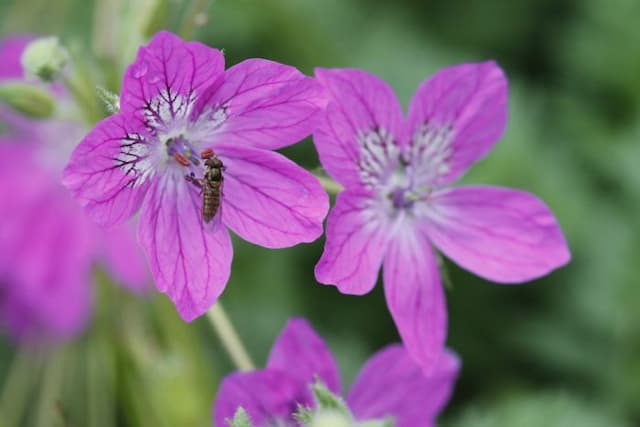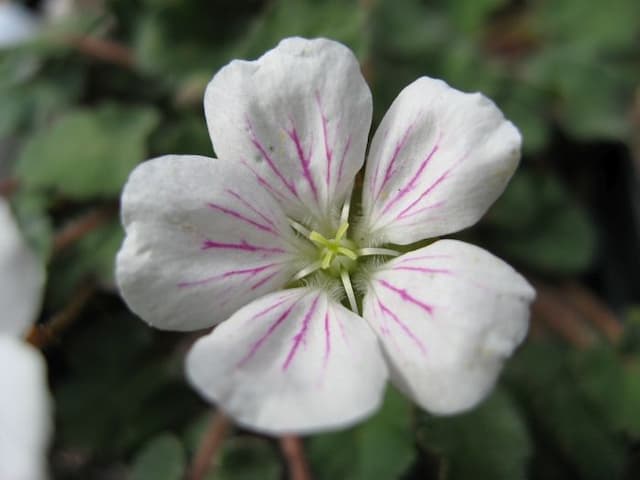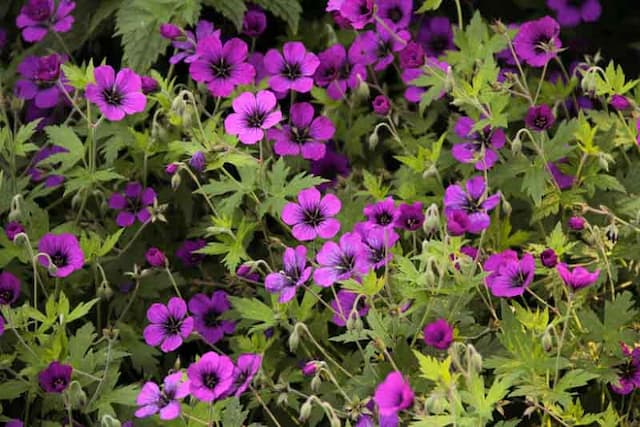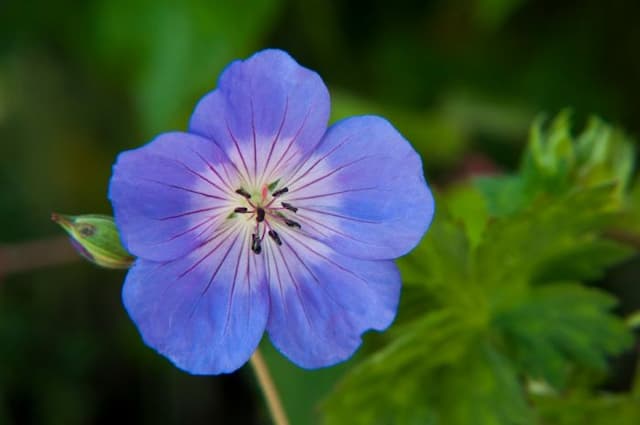Ivy Geranium Pelargonium 'Pink Rambler' (Z/d)

ABOUT
The Pelargonium 'Pink Rambler' is commonly known as the 'Pink Rambler' geranium. This plant is known for its beautiful and abundant pink flowers, which stand out with their delicate and rounded clusters. Each flower within these clusters showcases a classic geranium shape, with a grouping of soft petals that are often slightly ruffled at the edges, contributing to their overall charm. The color of the blooms ranges from pale to vibrant pink, often with noticeable veins or streaks of a slightly darker tone, adding depth and interest to the floral display. The foliage of the Pink Rambler geranium is equally attractive, typically characterized by lush green leaves that provide a perfect backdrop for the pink flowers. The leaves are usually rounded with scalloped or lobed edges, and they have a soft, velvety texture. Their shade of green can vary from light to a more robust dark green, and they often have a zonal pattern, which is a common trait in geranium leaves, showing darker circular marks on the leaves. The stems of the plant are sturdy and branching, which support both the mass of the flowers and the foliage. They may have a trailing or climbing habit, often used in garden designs where they can provide a cascade of color over walls or trellises. Additionally, the Pink Rambler may present a pleasant scent when the leaves are brushed or crushed, adding an aromatic dimension to both its visual appeal and tactile experience when handling the plant. Overall, the Pink Rambler geranium is a striking and romantic choice for gardens and container plantings, with its profusion of lovely pink flowers and attractive, dense foliage that lasts throughout the growing season.
About this plant
 Names
NamesFamily
Geraniaceae
Synonyms
Pink Rambler Geranium, Climbing Geranium, Ivy-leaf Geranium
Common names
Pelargonium 'Pink Rambler'
 Toxicity
ToxicityTo humans
Geranium (Pelargonium 'Pink Rambler') is generally considered non-toxic to humans. However, consuming large amounts of the plant can potentially cause mild irritation or an upset stomach, though it is not commonly known to have severe toxic effects when ingested.
To pets
Geranium (Pelargonium 'Pink Rambler') is known to be toxic to pets, especially dogs and cats. If ingested, it can cause symptoms such as vomiting, depression, anorexia, and dermatitis. In some cases, ingestion may lead to more severe reactions, necessitating prompt veterinary attention. Owners should prevent pets from accessing this plant to avoid the possibility of poisoning.
 Characteristics
CharacteristicsLife cycle
Perennials
Foliage type
Evergreen
Color of leaves
Green
Flower color
Pink
Height
1-2 feet (30-60 cm)
Spread
1-2 feet (30-60 cm)
Plant type
Shrub
Hardiness zones
10
Native area
South Africa
Benefits
 General Benefits
General Benefits- Visual Appeal: The Pelargonium 'Pink Rambler' is admired for its vibrant pink blooms that add color and aesthetic beauty to gardens and living spaces.
- Easy to Grow: This plant is known for being low maintenance and easy to cultivate, making it a great choice for both novice and experienced gardeners.
- Drought Tolerant: Once established, it is quite drought-resistant, requiring minimal watering and conserving water usage.
- Adaptable: It can thrive in a variety of soil types as long as they are well-drained.
- Long Blooming Season: The Pelargonium 'Pink Rambler' has a long flowering period, providing a consistently beautiful display for many months.
- Attracts Pollinators: The flowers attract butterflies and bees, supporting local ecosystems and pollination.
- Container Gardening: It is well-suited for pots and containers, making it an excellent choice for balconies, patios, and indoor settings.
- Landscape Versatility: This plant can be used in landscape design in a variety of ways, including as a groundcover, in mixed borders, or as a standout specimen plant.
- Propagation: Easily propagated from cuttings, allowing gardeners to create new plants and expand their gardens.
- Variety: It offers variety in the garden with its distinct pink flowering attributes, standing out among other green foliage.
 Medical Properties
Medical PropertiesThis plant is not used for medical purposes.
 Air-purifying Qualities
Air-purifying QualitiesThis plant is not specifically known for air purifying qualities.
 Other Uses
Other Uses- Pelargonium 'Pink Rambler' can be used in potpourris for its fragrance and color, adding a pleasant scent to a room when dried and mixed with other aromatic herbs.
- The leaves of the Pelargonium 'Pink Rambler' are sometimes used to flavor jellies, desserts, and teas, imparting a subtle rose-like essence.
- This plant can be employed as a natural insect repellent when planted in garden borders or when the leaves are rubbed onto the skin.
- When included in wreaths or floral arrangements, 'Pink Rambler' provides a decorative touch with its bright colored flowers and can last quite a while without water.
- The essential oils extracted from Pelargonium 'Pink Rambler' are occasionally used in homemade perfumes and scents for a floral note.
- This plant's vibrant flowers can be used to create natural dyes for fabrics, offering hues of pink and purple depending on the mordant used.
- The Pelargonium 'Pink Rambler' can play a role in educational projects or science fairs, demonstrating plant growth, flowering, and propagation techniques.
- Petals of the 'Pink Rambler' can be used to decorate cakes or garnish cocktails, providing an edible and ornamental element that is sure to impress guests.
- In arts and crafts, the pressed flowers of the Pelargonium 'Pink Rambler' can be incorporated into handmade paper or used in botanical prints.
- During social rituals or ceremonies, such as weddings or memorials, the 'Pink Rambler' can be symbolic for remembrance, adding a personal touch to the occasion.
Interesting Facts
 Feng Shui
Feng ShuiThe Geranium is not used in Feng Shui practice.
 Zodiac Sign Compitability
Zodiac Sign CompitabilityThe Geranium is not used in astrology practice.
 Plant Symbolism
Plant Symbolism- Hope: The 'Pink Rambler' Pelargonium, commonly known as Geranium, often symbolizes hope, expressing the sentiment of expecting positive outcomes and looking forward to the future.
- Friendship: Geraniums can represent close bonds and harmonious relationships, making them a suitable gift for friends.
- Gentility: The delicate pink hue of the 'Pink Rambler' Geranium is often associated with gentleness and a refined nature.
- Stability: Geraniums can symbolize a stable love or relationship as they are hardy plants that return each year, much like enduring affection.
- Good Health: As geraniums are commonly believed to promote a healthy environment, gifting this plant can be a wish for someone’s good health.
 Water
WaterFor the geranium, known as Pelargonium 'Pink Rambler', water the plant thoroughly when the top inch of soil feels dry to the touch. This might translate to watering once a week, but the frequency can depend on factors like temperature and humidity. Aim to provide the plant with about one gallon of water each time, ensuring that any excess can drain away to avoid waterlogging the soil. During the winter, reduce watering to every other week or when the soil is dry several inches deep, as overwatering can lead to root rot. Be careful not to wet the foliage, as this can encourage disease.
 Light
LightGeraniums require plenty of light, so place your Pelargonium 'Pink Rambler' in a spot where it can receive at least six to eight hours of direct sunlight daily. An east or west-facing window is ideal, as the plant will receive enough light without the harsh midday sun of a south-facing exposure, which can sometimes be too intense. Lack of adequate light can lead to leggy growth and fewer blooms.
 Temperature
TemperatureGeraniums thrive in temperatures between 65 and 75 degrees Fahrenheit during the day and between 55 and 65 degrees at night. The Pelargonium 'Pink Rambler' should not be exposed to temperatures below 50 degrees, as cold temperatures can be damaging. The plant prefers a consistent temperature range and should be protected from drafts and extreme heat sources.
 Pruning
PruningPruning geraniums, like the Pelargonium 'Pink Rambler', encourages bushier growth and more blooms. Trim back the plant in early spring and deadhead spent flowers regularly. If the plant becomes leggy during the summer, it can be pruned back by up to one-third to encourage new growth. The best time for major pruning is in the spring or after the plant has finished blooming.
 Cleaning
CleaningAs needed
 Soil
SoilGeraniums like Geranium 'Pink Rambler' prefer well-draining soil with a pH of 6.0 to 6.5. For the best soil mix, combine equal parts of peat moss, perlite, and potting soil, which ensures adequate drainage and aeration. This mixture supports healthy root growth and helps prevent waterlogging.
 Repotting
RepottingGeranium 'Pink Rambler' should be repotted every one to two years, or when it becomes root-bound. This frequency of repotting allows for fresh soil replenishment and room for continued root growth. Choose a container only slightly larger than the current one to ensure the best growth.
 Humidity & Misting
Humidity & MistingGeranium 'Pink Rambler' is tolerant of a wide range of humidity levels but prefers a moderate environment. Ideal humidity levels are between 40-60%. Avoid too high humidity to prevent disease and too low which can cause leaf desiccation.
 Suitable locations
Suitable locationsIndoor
Place Geranium 'Pink Rambler' in bright, indirect light and water regularly.
Outdoor
Ensure Geranium 'Pink Rambler' gets full sun to part shade and well-draining soil.
Hardiness zone
10-11 USDA
 Life cycle
Life cyclePelargonium 'Pink Rambler' (Z/d), commonly known as geranium 'Pink Rambler', begins its life cycle when a seed germinates, generally in warm and moist soil conditions. After germination, the seedling emerges, developing true leaves and a root system, gradually maturing into a young plant. The young geranium then enters a vegetative state where it grows stems and leaves, focusing on increasing its biomass and strengthening its structure. Once mature, it produces vibrant pink flowers, attracting pollinators, which is crucial for the reproductive stage where pollination occurs. After successful pollination, seeds are formed within fruits, completing the life cycle when these seeds are dispersed, ready to germinate and grow into new plants. Throughout the growing season, this perennial plant can undergo multiple flowering and seeding phases as long as conditions are favorable, but will eventually become dormant during adverse conditions, resuming growth with the return of favorable weather.
 Propogation
PropogationPropogation time
Spring-Early Summer
Propogation: The most popular method of propagating the Geranium 'Pink Rambler' is by stem cuttings. This process generally takes place during the spring or early summer when the plant's growth is most vigorous. To propagate, a gardener should select healthy, non-flowering stems and cut a piece about 4 to 6 inches (10 to 15 centimeters) in length. The bottom leaves of the cutting are then removed, and the cut end can be dipped in rooting hormone to encourage root development. The stem cutting is then planted in a pot filled with a well-draining soil mix, and it should be kept moist but not waterlogged. Placed in a bright, indirect light environment, roots will typically begin to form in a few weeks, after which the new plant can gradually be acclimated to the same growing conditions as the parent plant.






![Cranesbill [Rothbury Gem]](/_next/image?url=https%3A%2F%2Fplants-admin.emdemapps.com%2Fimages%2Fplants%2F%2Fimages%2F604b6243984c2.png&w=640&q=75)


